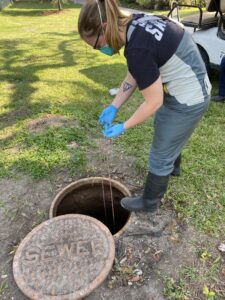The current COVID-19 surveillance, which does not adequately test asymptomatic individuals, limits the ability of decision makers to determine when and where outbreaks are occurring within their communities. There is a critical need for additional methods to assess and track the spread of SARS-CoV-2 at the community level, as undiagnosed infections are driving disease transmission. SARS-CoV-2 also can infect gastrointestinal glandular epithelial cells and is excreted in feces of infected individuals including asymptomatic individuals. Therefore, the virus could enter the sewer system via human excretions. This suggests that wastewater may be used to monitor progression or abatement of viral spread at the community level complementary to individual testing. The project objectives are to: (1) further develop and fine-tune sample concentration and detection method for SARS-CoV-2 in complex wastewater matrix; and (2) determine the abundance, diversity, and temporal dynamics of SARS-CoV-2 in wastewater.

We established and evaluated methodology for detecting and quantifying SARS-CoV-2 in wastewater. A year of wastewater epidemiology study of five wastewater facilities in Southeast Louisiana (New Orleans, Kenner, Jefferson East and Hammond) was conducted. RNA from SARS-CoV-2 was detectable in 83% of 243 wastewater samples. Distinct trends in SARS-CoV-2 RNA abundance versus COVID-19 case counts were observable. We also evaluated the efficacy of targeted wastewater surveillance of SARS-CoV-2 RNA together with individual-level testing for outbreak mitigation on Tulane University campus during Fall 2020 semester. Wastewater samples (n=117) were collected weekly from manholes or sewer cleanouts that receive wastewater inputs from dormitories, community-use buildings, and a COVID-19 isolation dormitory. In this study, temporal trends of SARS-CoV-2 in wastewater samples mirrored trends in COVID-19 cases detected on campus. This project provides evidence of the utility of wastewater-based epidemiology to assist in public health responses to COVID-19.


